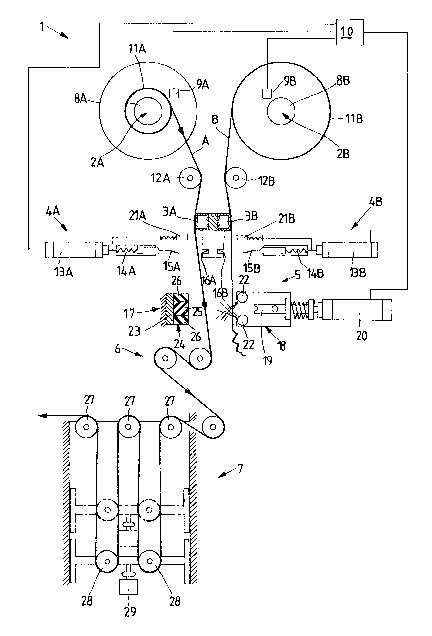Some of the information on this Web page has been provided by external sources. The Government of Canada is not responsible for the accuracy, reliability or currency of the information supplied by external sources. Users wishing to rely upon this information should consult directly with the source of the information. Content provided by external sources is not subject to official languages, privacy and accessibility requirements.
Any discrepancies in the text and image of the Claims and Abstract are due to differing posting times. Text of the Claims and Abstract are posted:
| (12) Patent Application: | (11) CA 2102874 |
|---|---|
| (54) English Title: | DEVICE FOR JOINING FILMS OF HEAT-SHRINKABLE PLASTIC MATERIAL IN A MACHINE USING SAID FILM |
| (54) French Title: | DISPOSITIF POUR REUNIR DES PELLICULES EN MATERIAU PLASTIQUE THERMORETRACTABLE DANS UNE MACHINE UTILISANT CES PELLICULES |
| Status: | Deemed Abandoned and Beyond the Period of Reinstatement - Pending Response to Notice of Disregarded Communication |
| (51) International Patent Classification (IPC): |
|
|---|---|
| (72) Inventors : |
|
| (73) Owners : |
|
| (71) Applicants : |
|
| (74) Agent: | MARKS & CLERK |
| (74) Associate agent: | |
| (45) Issued: | |
| (22) Filed Date: | 1993-11-10 |
| (41) Open to Public Inspection: | 1994-05-12 |
| Examination requested: | 2000-08-15 |
| Availability of licence: | N/A |
| Dedicated to the Public: | N/A |
| (25) Language of filing: | English |
| Patent Cooperation Treaty (PCT): | No |
|---|
| (30) Application Priority Data: | ||||||
|---|---|---|---|---|---|---|
|
Abstract
In order to make it possible the bobbin (11A) of
heat-shrinkable plastic material film to be replaced
without stopping the machine which uses it, the device
(1) substantially comprises, listed in the direction
of film (A-B) unwinding, one pair of parallel reels
(2A, 2B), respectively supporting the bobbins (11A,
11B) on which the film (A-B) is wound, two sucking
mouths (3A, 3B), two cutting devices (4A, 4B), a
welding device (6) and an accumulation device (7).
Note: Claims are shown in the official language in which they were submitted.
Note: Descriptions are shown in the official language in which they were submitted.

2024-08-01:As part of the Next Generation Patents (NGP) transition, the Canadian Patents Database (CPD) now contains a more detailed Event History, which replicates the Event Log of our new back-office solution.
Please note that "Inactive:" events refers to events no longer in use in our new back-office solution.
For a clearer understanding of the status of the application/patent presented on this page, the site Disclaimer , as well as the definitions for Patent , Event History , Maintenance Fee and Payment History should be consulted.
| Description | Date |
|---|---|
| Inactive: IPC from MCD | 2006-03-11 |
| Inactive: IPC from MCD | 2006-03-11 |
| Inactive: IPC from MCD | 2006-03-11 |
| Application Not Reinstated by Deadline | 2004-11-10 |
| Time Limit for Reversal Expired | 2004-11-10 |
| Inactive: Abandoned - No reply to s.30(2) Rules requisition | 2004-03-24 |
| Deemed Abandoned - Failure to Respond to Maintenance Fee Notice | 2003-11-10 |
| Inactive: S.30(2) Rules - Examiner requisition | 2003-09-24 |
| Amendment Received - Voluntary Amendment | 2001-02-12 |
| Letter Sent | 2000-09-22 |
| Inactive: Status info is complete as of Log entry date | 2000-09-22 |
| Inactive: Application prosecuted on TS as of Log entry date | 2000-09-22 |
| All Requirements for Examination Determined Compliant | 2000-08-15 |
| Request for Examination Requirements Determined Compliant | 2000-08-15 |
| Application Published (Open to Public Inspection) | 1994-05-12 |
| Abandonment Date | Reason | Reinstatement Date |
|---|---|---|
| 2003-11-10 |
The last payment was received on 2002-10-28
Note : If the full payment has not been received on or before the date indicated, a further fee may be required which may be one of the following
Please refer to the CIPO Patent Fees web page to see all current fee amounts.
| Fee Type | Anniversary Year | Due Date | Paid Date |
|---|---|---|---|
| MF (application, 4th anniv.) - standard | 04 | 1997-11-10 | 1997-10-20 |
| MF (application, 5th anniv.) - standard | 05 | 1998-11-10 | 1998-10-20 |
| MF (application, 6th anniv.) - standard | 06 | 1999-11-10 | 1999-10-28 |
| Request for examination - standard | 2000-08-15 | ||
| MF (application, 7th anniv.) - standard | 07 | 2000-11-10 | 2000-10-26 |
| MF (application, 8th anniv.) - standard | 08 | 2001-11-13 | 2001-11-02 |
| MF (application, 9th anniv.) - standard | 09 | 2002-11-11 | 2002-10-28 |
Note: Records showing the ownership history in alphabetical order.
| Current Owners on Record |
|---|
| OCME S.R.L. |
| Past Owners on Record |
|---|
| EMANUELE GATTESCHI |